Critical Evaluation of Wembley Stadium and MSG Project Management
VerifiedAdded on 2021/01/08
|23
|6000
|171
Report
AI Summary
This report critically evaluates the project management approaches used in the construction of Wembley Stadium and Madison Square Garden, two iconic stadium projects. It begins by examining the methodologies employed, contrasting the waterfall approach used at Wembley with the more agile, phased approach at MSG. The report then delves into key project management knowledge areas, including schedule, scope, and cost management, highlighting the impact of decisions made in each area. It analyzes the financial aspects of both projects, noting significant cost overruns at both stadiums, but particularly at Wembley. Furthermore, the report incorporates a PESTLE analysis to assess the external environmental factors influencing each project. Finally, the report offers recommendations based on the successes and failures of each project, providing insights applicable to future stadium construction projects and emphasizing the importance of adaptable methodologies and meticulous planning. The report emphasizes the critical role of project management in achieving project success, even when the final product is successful.
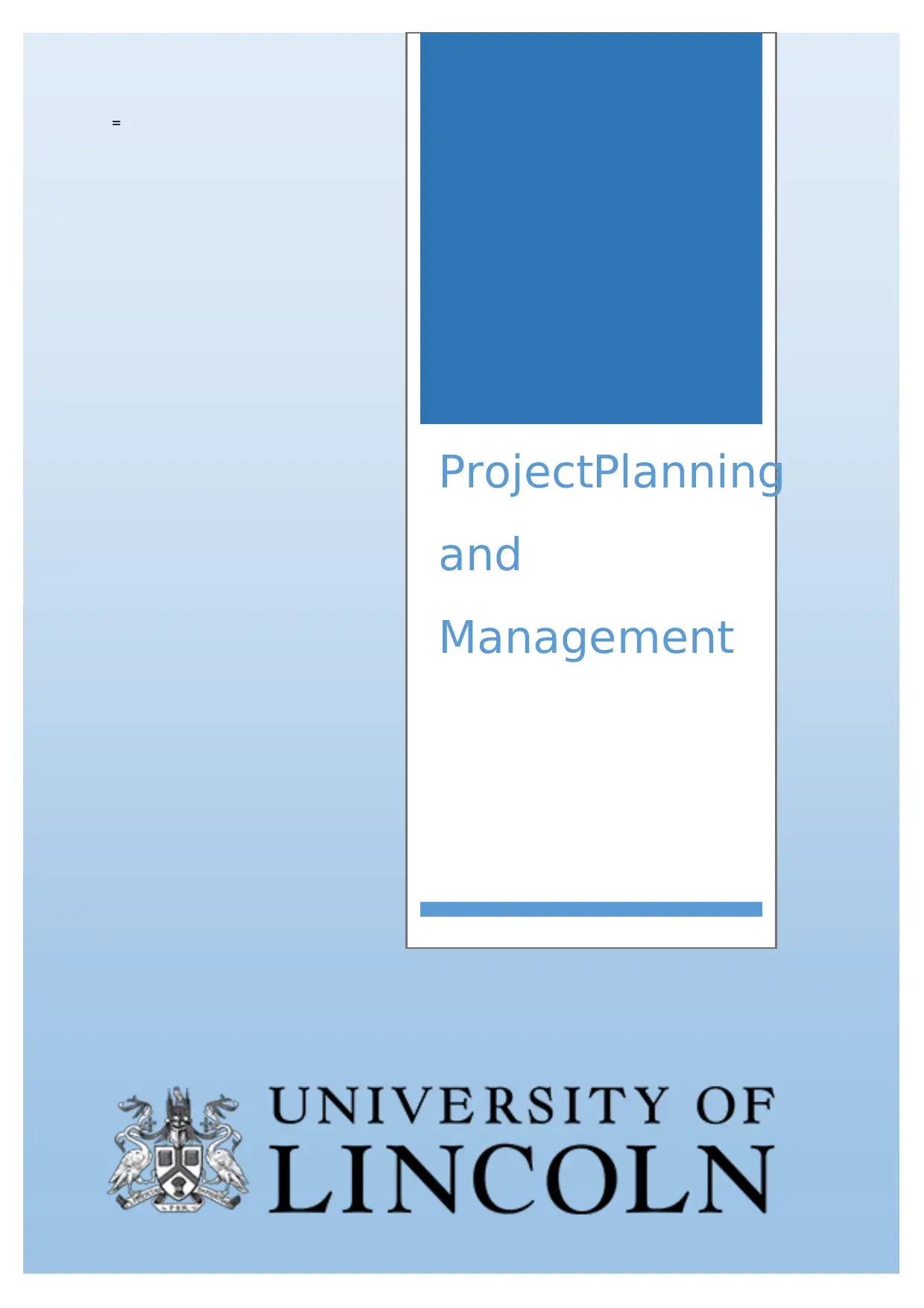
=
ProjectPlanning
and
Management
ProjectPlanning
and
Management
Paraphrase This Document
Need a fresh take? Get an instant paraphrase of this document with our AI Paraphraser
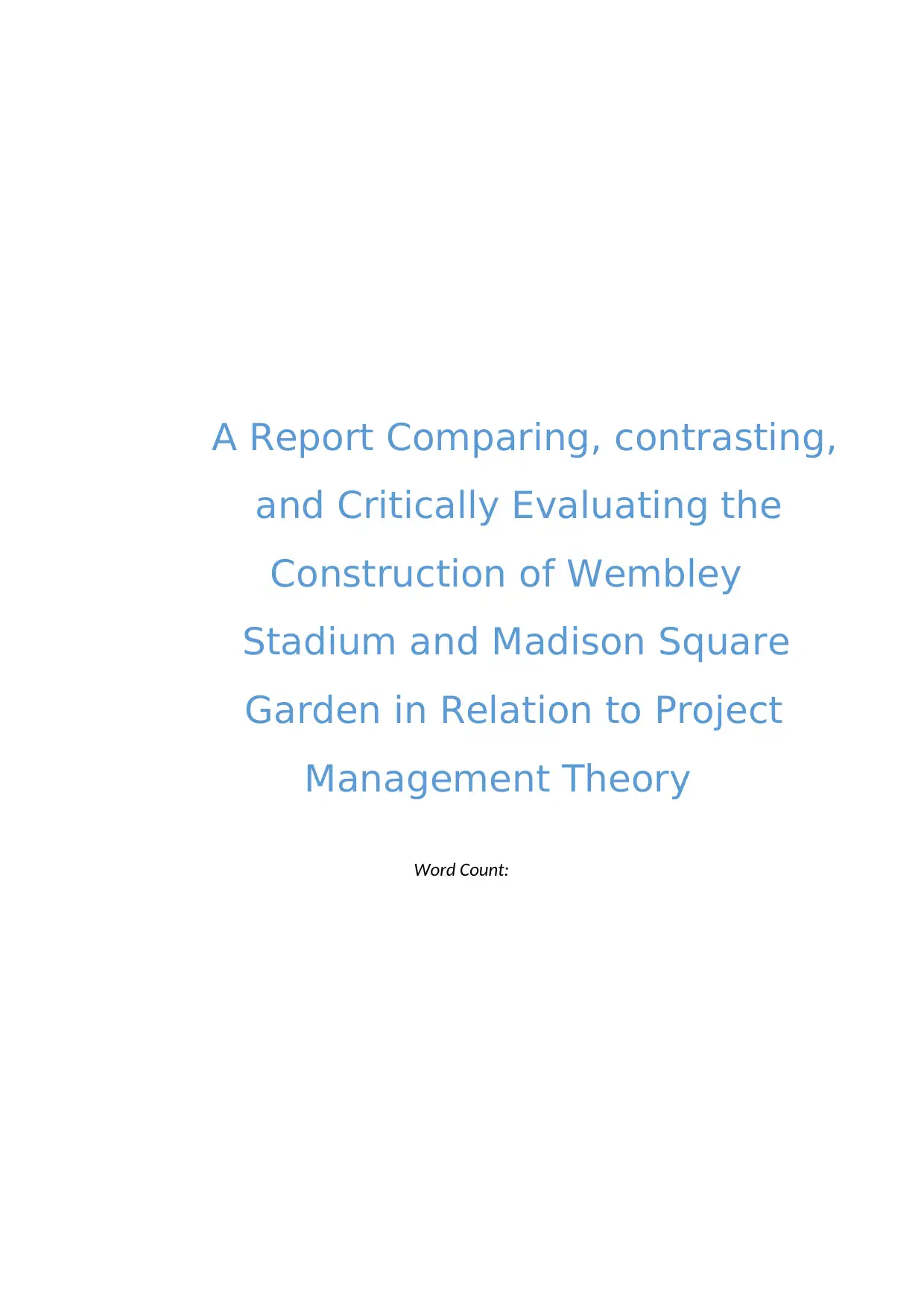
A Report Comparing, contrasting,
and Critically Evaluating the
Construction of Wembley
Stadium and Madison Square
Garden in Relation to Project
Management Theory
Word Count:
and Critically Evaluating the
Construction of Wembley
Stadium and Madison Square
Garden in Relation to Project
Management Theory
Word Count:
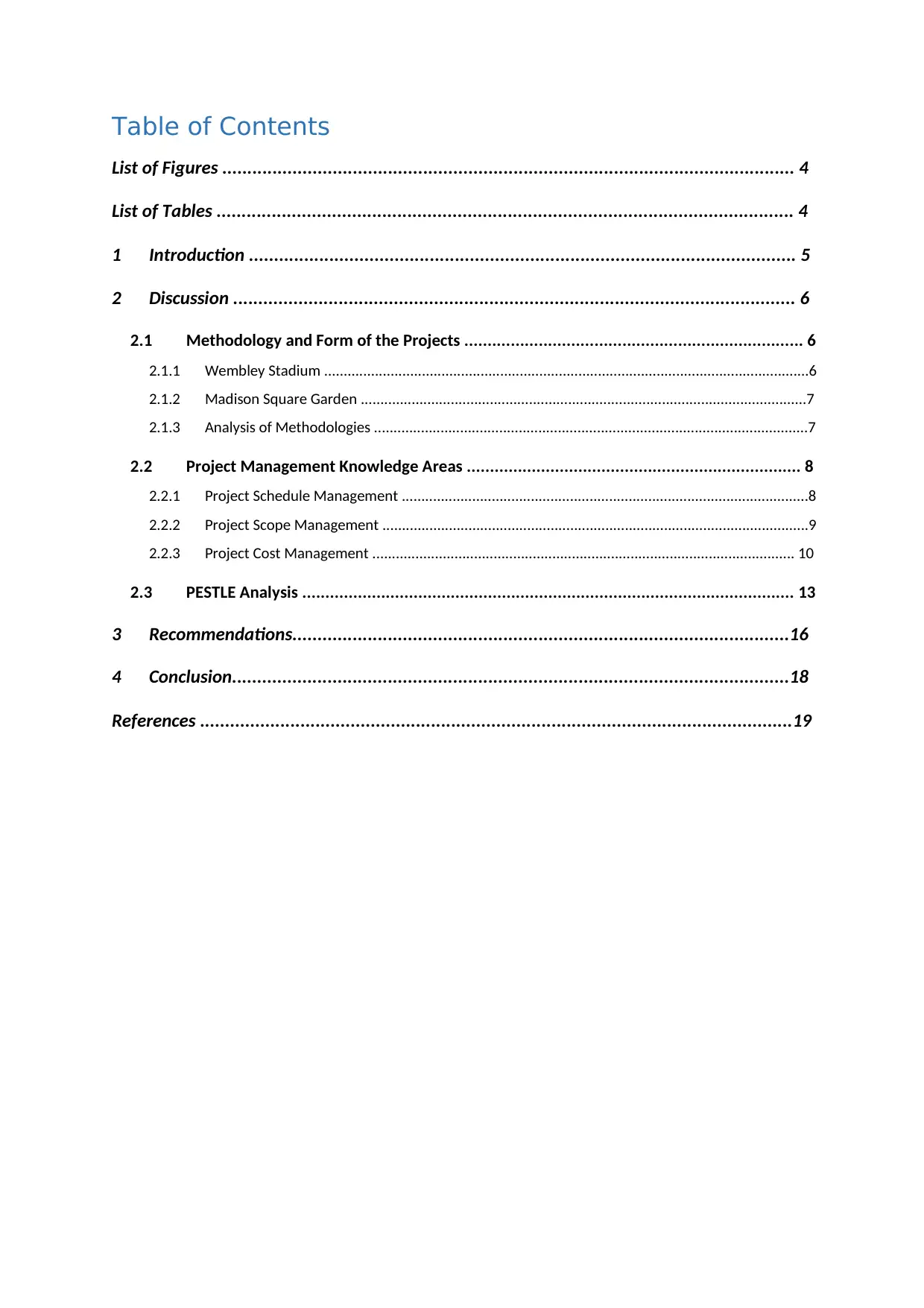
Table of Contents
List of Figures .................................................................................................................. 4
List of Tables ................................................................................................................... 4
1 Introduction ............................................................................................................. 5
2 Discussion ................................................................................................................ 6
2.1 Methodology and Form of the Projects ......................................................................... 6
2.1.1 Wembley Stadium ............................................................................................................................6
2.1.2 Madison Square Garden ..................................................................................................................7
2.1.3 Analysis of Methodologies ...............................................................................................................7
2.2 Project Management Knowledge Areas ........................................................................ 8
2.2.1 Project Schedule Management ........................................................................................................8
2.2.2 Project Scope Management .............................................................................................................9
2.2.3 Project Cost Management ............................................................................................................ 10
2.3 PESTLE Analysis .......................................................................................................... 13
3 Recommendations...................................................................................................16
4 Conclusion...............................................................................................................18
References ......................................................................................................................19
List of Figures .................................................................................................................. 4
List of Tables ................................................................................................................... 4
1 Introduction ............................................................................................................. 5
2 Discussion ................................................................................................................ 6
2.1 Methodology and Form of the Projects ......................................................................... 6
2.1.1 Wembley Stadium ............................................................................................................................6
2.1.2 Madison Square Garden ..................................................................................................................7
2.1.3 Analysis of Methodologies ...............................................................................................................7
2.2 Project Management Knowledge Areas ........................................................................ 8
2.2.1 Project Schedule Management ........................................................................................................8
2.2.2 Project Scope Management .............................................................................................................9
2.2.3 Project Cost Management ............................................................................................................ 10
2.3 PESTLE Analysis .......................................................................................................... 13
3 Recommendations...................................................................................................16
4 Conclusion...............................................................................................................18
References ......................................................................................................................19
⊘ This is a preview!⊘
Do you want full access?
Subscribe today to unlock all pages.

Trusted by 1+ million students worldwide
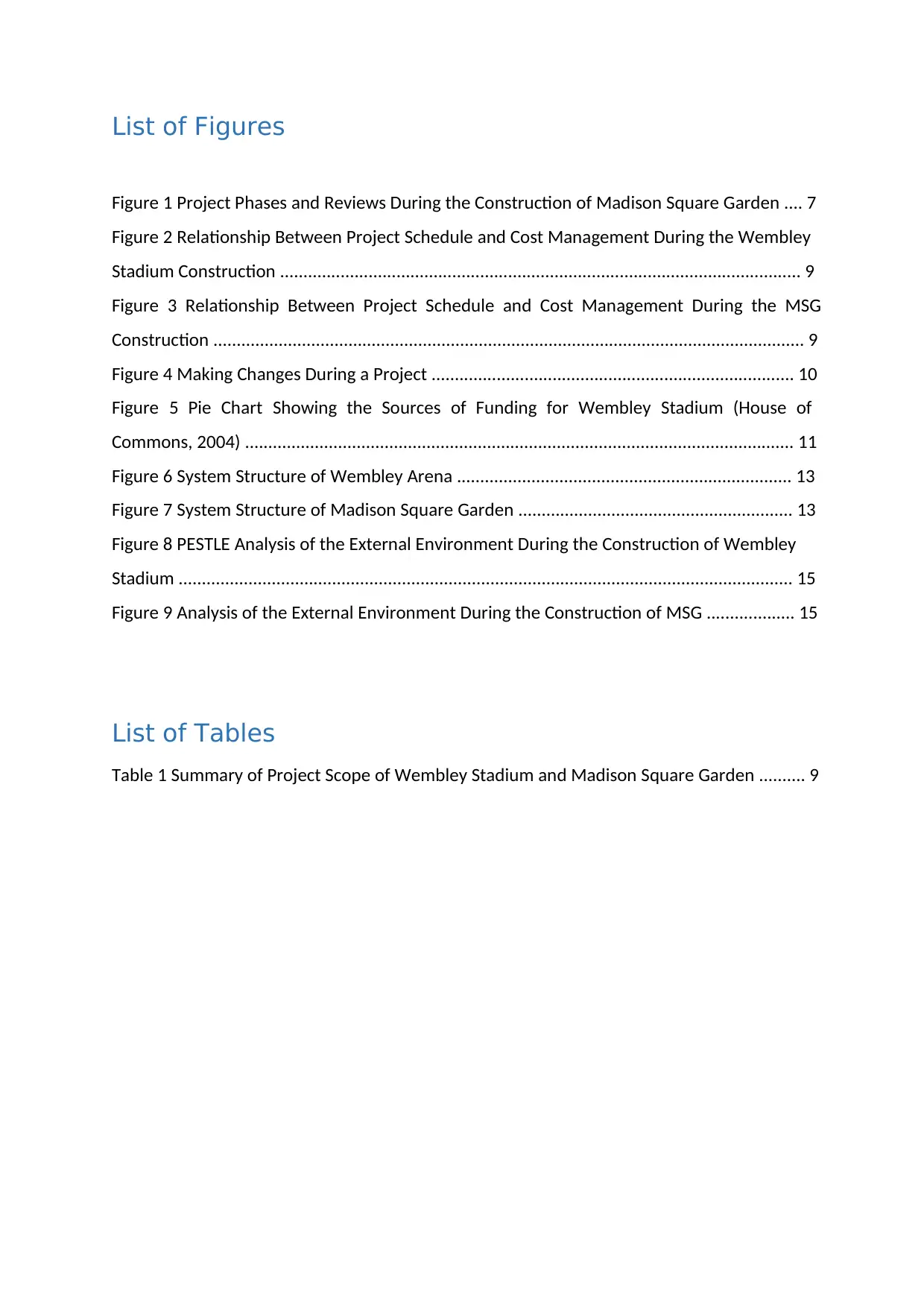
List of Figures
Figure 1 Project Phases and Reviews During the Construction of Madison Square Garden .... 7
Figure 2 Relationship Between Project Schedule and Cost Management During the Wembley
Stadium Construction ................................................................................................................ 9
Figure 3 Relationship Between Project Schedule and Cost Management During the MSG
Construction ............................................................................................................................... 9
Figure 4 Making Changes During a Project .............................................................................. 10
Figure 5 Pie Chart Showing the Sources of Funding for Wembley Stadium (House of
Commons, 2004) ...................................................................................................................... 11
Figure 6 System Structure of Wembley Arena ........................................................................ 13
Figure 7 System Structure of Madison Square Garden ........................................................... 13
Figure 8 PESTLE Analysis of the External Environment During the Construction of Wembley
Stadium .................................................................................................................................... 15
Figure 9 Analysis of the External Environment During the Construction of MSG ................... 15
List of Tables
Table 1 Summary of Project Scope of Wembley Stadium and Madison Square Garden .......... 9
Figure 1 Project Phases and Reviews During the Construction of Madison Square Garden .... 7
Figure 2 Relationship Between Project Schedule and Cost Management During the Wembley
Stadium Construction ................................................................................................................ 9
Figure 3 Relationship Between Project Schedule and Cost Management During the MSG
Construction ............................................................................................................................... 9
Figure 4 Making Changes During a Project .............................................................................. 10
Figure 5 Pie Chart Showing the Sources of Funding for Wembley Stadium (House of
Commons, 2004) ...................................................................................................................... 11
Figure 6 System Structure of Wembley Arena ........................................................................ 13
Figure 7 System Structure of Madison Square Garden ........................................................... 13
Figure 8 PESTLE Analysis of the External Environment During the Construction of Wembley
Stadium .................................................................................................................................... 15
Figure 9 Analysis of the External Environment During the Construction of MSG ................... 15
List of Tables
Table 1 Summary of Project Scope of Wembley Stadium and Madison Square Garden .......... 9
Paraphrase This Document
Need a fresh take? Get an instant paraphrase of this document with our AI Paraphraser
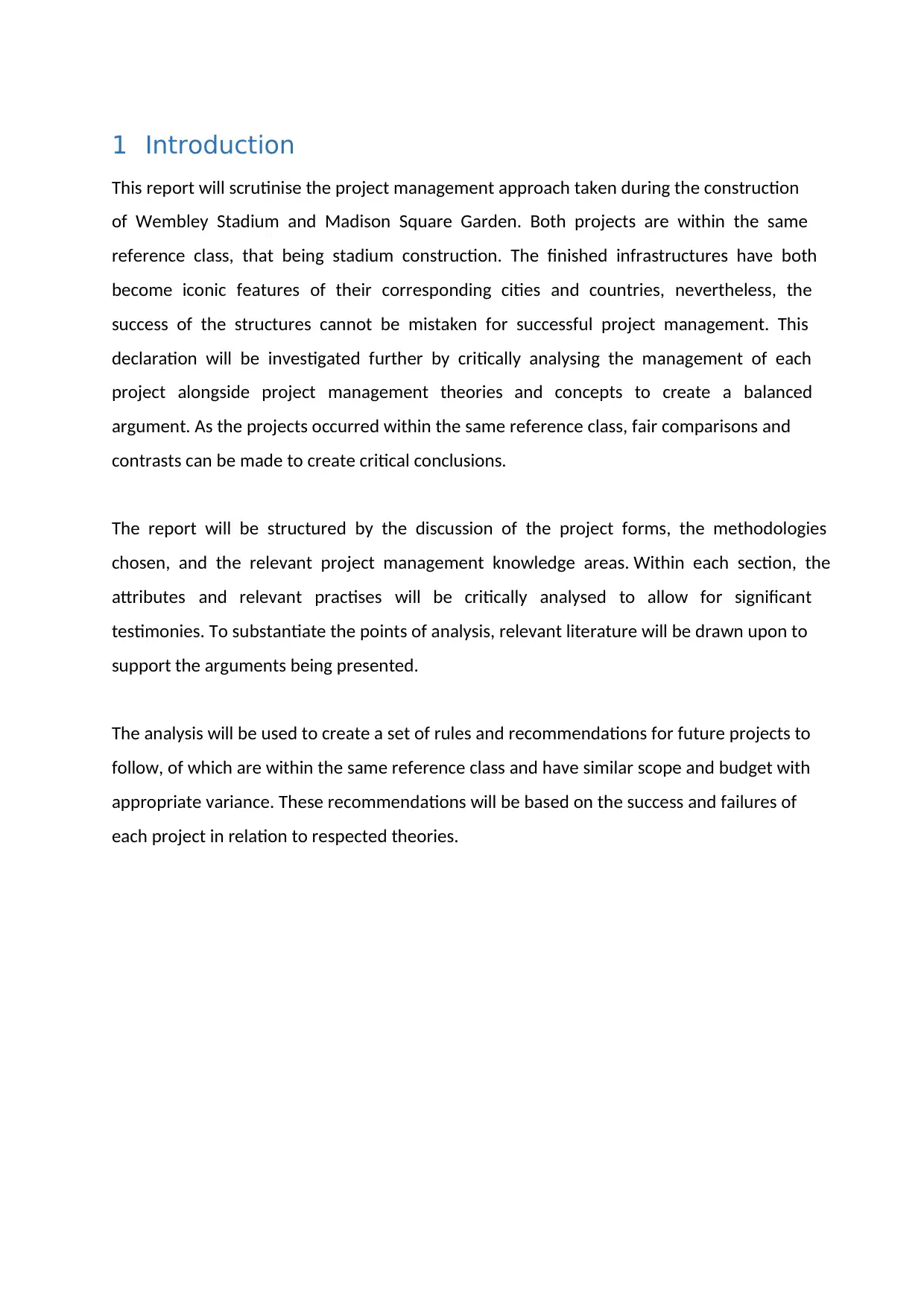
1 Introduction
This report will scrutinise the project management approach taken during the construction
of Wembley Stadium and Madison Square Garden. Both projects are within the same
reference class, that being stadium construction. The finished infrastructures have both
become iconic features of their corresponding cities and countries, nevertheless, the
success of the structures cannot be mistaken for successful project management. This
declaration will be investigated further by critically analysing the management of each
project alongside project management theories and concepts to create a balanced
argument. As the projects occurred within the same reference class, fair comparisons and
contrasts can be made to create critical conclusions.
The report will be structured by the discussion of the project forms, the methodologies
chosen, and the relevant project management knowledge areas. Within each section, the
attributes and relevant practises will be critically analysed to allow for significant
testimonies. To substantiate the points of analysis, relevant literature will be drawn upon to
support the arguments being presented.
The analysis will be used to create a set of rules and recommendations for future projects to
follow, of which are within the same reference class and have similar scope and budget with
appropriate variance. These recommendations will be based on the success and failures of
each project in relation to respected theories.
This report will scrutinise the project management approach taken during the construction
of Wembley Stadium and Madison Square Garden. Both projects are within the same
reference class, that being stadium construction. The finished infrastructures have both
become iconic features of their corresponding cities and countries, nevertheless, the
success of the structures cannot be mistaken for successful project management. This
declaration will be investigated further by critically analysing the management of each
project alongside project management theories and concepts to create a balanced
argument. As the projects occurred within the same reference class, fair comparisons and
contrasts can be made to create critical conclusions.
The report will be structured by the discussion of the project forms, the methodologies
chosen, and the relevant project management knowledge areas. Within each section, the
attributes and relevant practises will be critically analysed to allow for significant
testimonies. To substantiate the points of analysis, relevant literature will be drawn upon to
support the arguments being presented.
The analysis will be used to create a set of rules and recommendations for future projects to
follow, of which are within the same reference class and have similar scope and budget with
appropriate variance. These recommendations will be based on the success and failures of
each project in relation to respected theories.
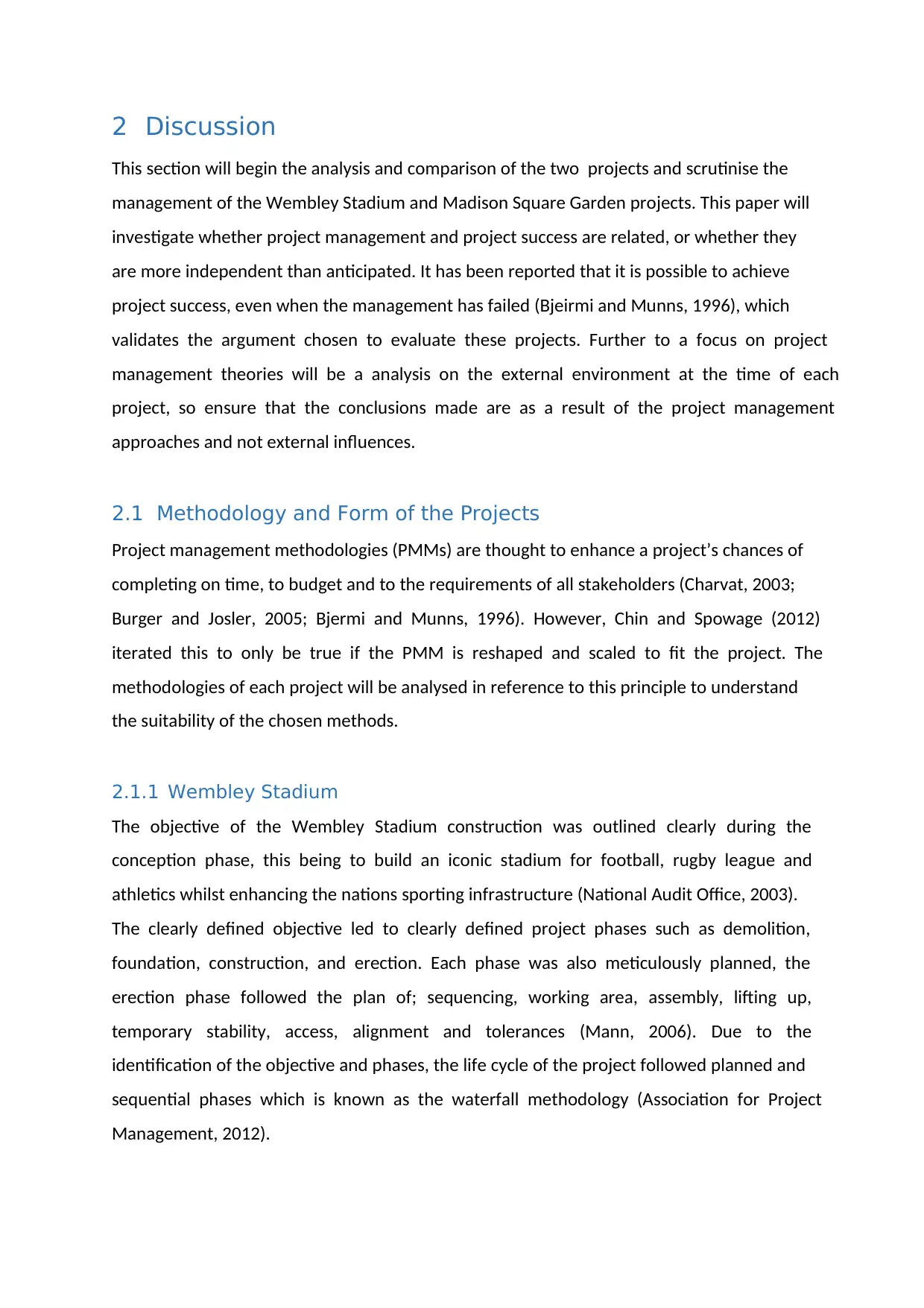
2 Discussion
This section will begin the analysis and comparison of the two projects and scrutinise the
management of the Wembley Stadium and Madison Square Garden projects. This paper will
investigate whether project management and project success are related, or whether they
are more independent than anticipated. It has been reported that it is possible to achieve
project success, even when the management has failed (Bjeirmi and Munns, 1996), which
validates the argument chosen to evaluate these projects. Further to a focus on project
management theories will be a analysis on the external environment at the time of each
project, so ensure that the conclusions made are as a result of the project management
approaches and not external influences.
2.1 Methodology and Form of the Projects
Project management methodologies (PMMs) are thought to enhance a project’s chances of
completing on time, to budget and to the requirements of all stakeholders (Charvat, 2003;
Burger and Josler, 2005; Bjermi and Munns, 1996). However, Chin and Spowage (2012)
iterated this to only be true if the PMM is reshaped and scaled to fit the project. The
methodologies of each project will be analysed in reference to this principle to understand
the suitability of the chosen methods.
2.1.1 Wembley Stadium
The objective of the Wembley Stadium construction was outlined clearly during the
conception phase, this being to build an iconic stadium for football, rugby league and
athletics whilst enhancing the nations sporting infrastructure (National Audit Office, 2003).
The clearly defined objective led to clearly defined project phases such as demolition,
foundation, construction, and erection. Each phase was also meticulously planned, the
erection phase followed the plan of; sequencing, working area, assembly, lifting up,
temporary stability, access, alignment and tolerances (Mann, 2006). Due to the
identification of the objective and phases, the life cycle of the project followed planned and
sequential phases which is known as the waterfall methodology (Association for Project
Management, 2012).
This section will begin the analysis and comparison of the two projects and scrutinise the
management of the Wembley Stadium and Madison Square Garden projects. This paper will
investigate whether project management and project success are related, or whether they
are more independent than anticipated. It has been reported that it is possible to achieve
project success, even when the management has failed (Bjeirmi and Munns, 1996), which
validates the argument chosen to evaluate these projects. Further to a focus on project
management theories will be a analysis on the external environment at the time of each
project, so ensure that the conclusions made are as a result of the project management
approaches and not external influences.
2.1 Methodology and Form of the Projects
Project management methodologies (PMMs) are thought to enhance a project’s chances of
completing on time, to budget and to the requirements of all stakeholders (Charvat, 2003;
Burger and Josler, 2005; Bjermi and Munns, 1996). However, Chin and Spowage (2012)
iterated this to only be true if the PMM is reshaped and scaled to fit the project. The
methodologies of each project will be analysed in reference to this principle to understand
the suitability of the chosen methods.
2.1.1 Wembley Stadium
The objective of the Wembley Stadium construction was outlined clearly during the
conception phase, this being to build an iconic stadium for football, rugby league and
athletics whilst enhancing the nations sporting infrastructure (National Audit Office, 2003).
The clearly defined objective led to clearly defined project phases such as demolition,
foundation, construction, and erection. Each phase was also meticulously planned, the
erection phase followed the plan of; sequencing, working area, assembly, lifting up,
temporary stability, access, alignment and tolerances (Mann, 2006). Due to the
identification of the objective and phases, the life cycle of the project followed planned and
sequential phases which is known as the waterfall methodology (Association for Project
Management, 2012).
⊘ This is a preview!⊘
Do you want full access?
Subscribe today to unlock all pages.

Trusted by 1+ million students worldwide
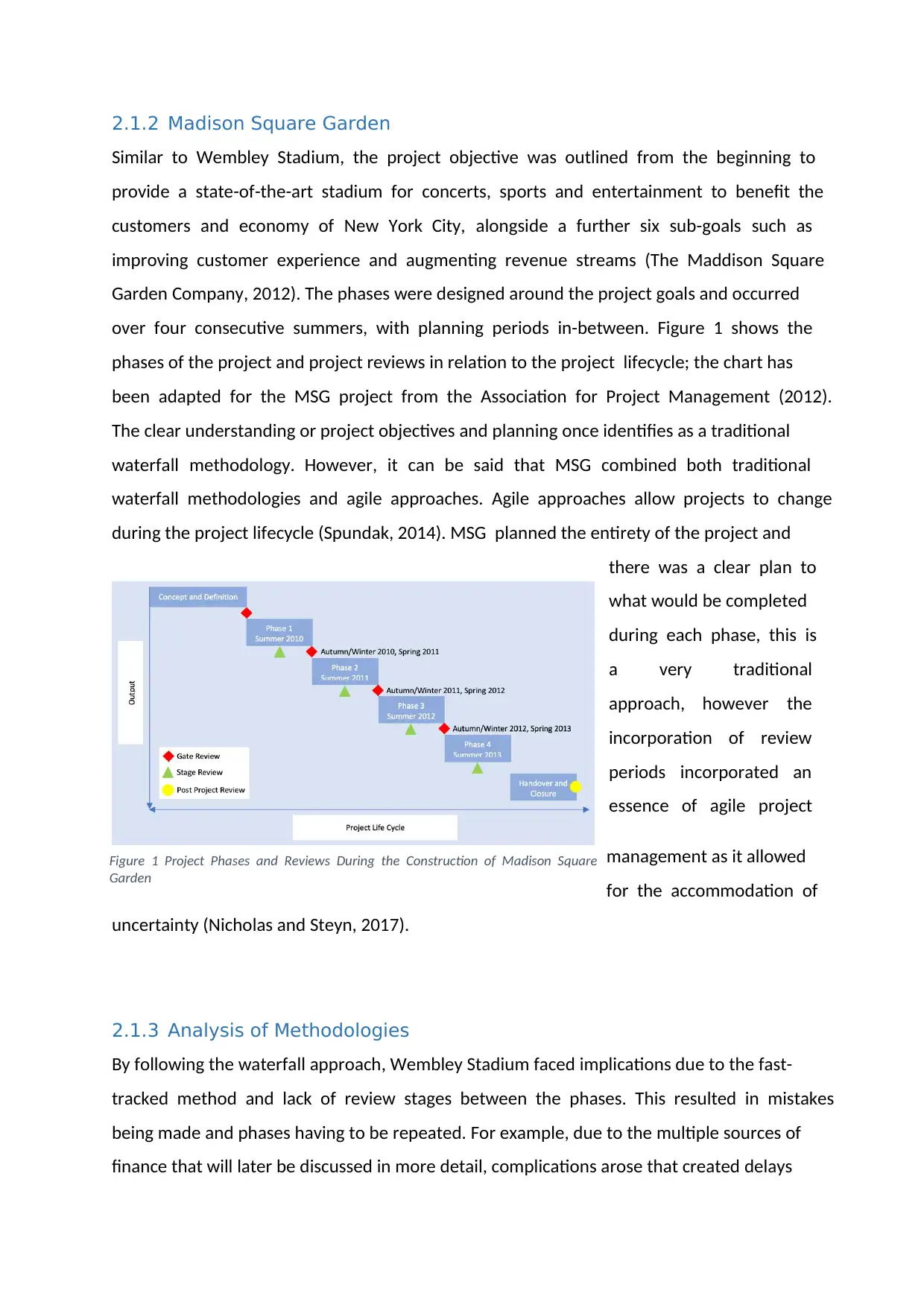
2.1.2 Madison Square Garden
Similar to Wembley Stadium, the project objective was outlined from the beginning to
provide a state-of-the-art stadium for concerts, sports and entertainment to benefit the
customers and economy of New York City, alongside a further six sub-goals such as
improving customer experience and augmenting revenue streams (The Maddison Square
Garden Company, 2012). The phases were designed around the project goals and occurred
over four consecutive summers, with planning periods in-between. Figure 1 shows the
phases of the project and project reviews in relation to the project lifecycle; the chart has
been adapted for the MSG project from the Association for Project Management (2012).
The clear understanding or project objectives and planning once identifies as a traditional
waterfall methodology. However, it can be said that MSG combined both traditional
waterfall methodologies and agile approaches. Agile approaches allow projects to change
during the project lifecycle (Spundak, 2014). MSG planned the entirety of the project and
there was a clear plan to
what would be completed
during each phase, this is
a very traditional
approach, however the
incorporation of review
periods incorporated an
essence of agile project
management as it allowed
for the accommodation of
uncertainty (Nicholas and Steyn, 2017).
2.1.3 Analysis of Methodologies
By following the waterfall approach, Wembley Stadium faced implications due to the fast-
tracked method and lack of review stages between the phases. This resulted in mistakes
being made and phases having to be repeated. For example, due to the multiple sources of
finance that will later be discussed in more detail, complications arose that created delays
Figure 1 Project Phases and Reviews During the Construction of Madison Square
Garden
Similar to Wembley Stadium, the project objective was outlined from the beginning to
provide a state-of-the-art stadium for concerts, sports and entertainment to benefit the
customers and economy of New York City, alongside a further six sub-goals such as
improving customer experience and augmenting revenue streams (The Maddison Square
Garden Company, 2012). The phases were designed around the project goals and occurred
over four consecutive summers, with planning periods in-between. Figure 1 shows the
phases of the project and project reviews in relation to the project lifecycle; the chart has
been adapted for the MSG project from the Association for Project Management (2012).
The clear understanding or project objectives and planning once identifies as a traditional
waterfall methodology. However, it can be said that MSG combined both traditional
waterfall methodologies and agile approaches. Agile approaches allow projects to change
during the project lifecycle (Spundak, 2014). MSG planned the entirety of the project and
there was a clear plan to
what would be completed
during each phase, this is
a very traditional
approach, however the
incorporation of review
periods incorporated an
essence of agile project
management as it allowed
for the accommodation of
uncertainty (Nicholas and Steyn, 2017).
2.1.3 Analysis of Methodologies
By following the waterfall approach, Wembley Stadium faced implications due to the fast-
tracked method and lack of review stages between the phases. This resulted in mistakes
being made and phases having to be repeated. For example, due to the multiple sources of
finance that will later be discussed in more detail, complications arose that created delays
Figure 1 Project Phases and Reviews During the Construction of Madison Square
Garden
Paraphrase This Document
Need a fresh take? Get an instant paraphrase of this document with our AI Paraphraser
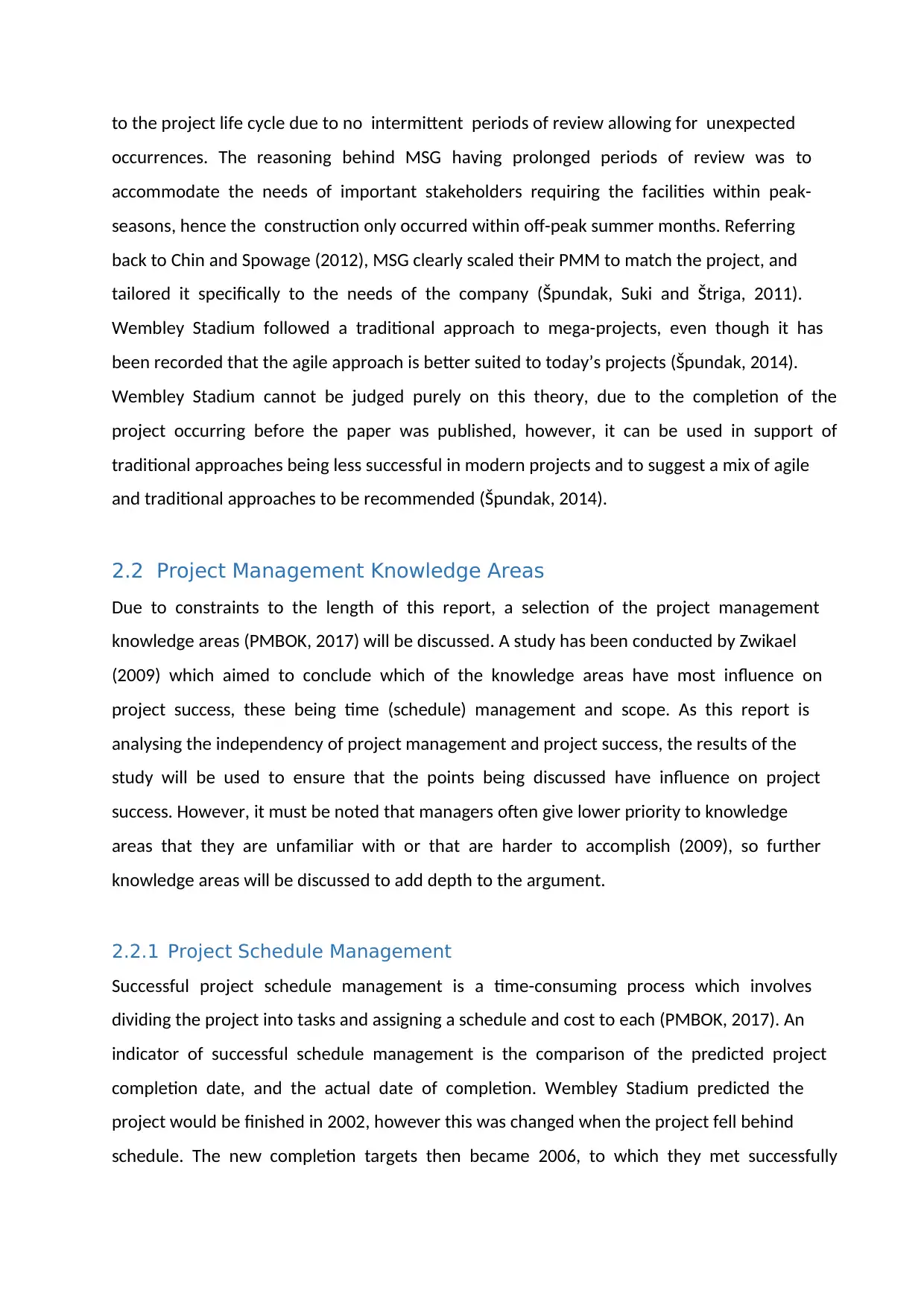
to the project life cycle due to no intermittent periods of review allowing for unexpected
occurrences. The reasoning behind MSG having prolonged periods of review was to
accommodate the needs of important stakeholders requiring the facilities within peak-
seasons, hence the construction only occurred within off-peak summer months. Referring
back to Chin and Spowage (2012), MSG clearly scaled their PMM to match the project, and
tailored it specifically to the needs of the company (Špundak, Suki andŠ triga, 2011).
Wembley Stadium followed a traditional approach to mega-projects, even though it has
been recorded that the agile approach is better suited to today’s projects (Špundak, 2014).
Wembley Stadium cannot be judged purely on this theory, due to the completion of the
project occurring before the paper was published, however, it can be used in support of
traditional approaches being less successful in modern projects and to suggest a mix of agile
and traditional approaches to be recommended (Špundak, 2014).
2.2 Project Management Knowledge Areas
Due to constraints to the length of this report, a selection of the project management
knowledge areas (PMBOK, 2017) will be discussed. A study has been conducted by Zwikael
(2009) which aimed to conclude which of the knowledge areas have most influence on
project success, these being time (schedule) management and scope. As this report is
analysing the independency of project management and project success, the results of the
study will be used to ensure that the points being discussed have influence on project
success. However, it must be noted that managers often give lower priority to knowledge
areas that they are unfamiliar with or that are harder to accomplish (2009), so further
knowledge areas will be discussed to add depth to the argument.
2.2.1 Project Schedule Management
Successful project schedule management is a time-consuming process which involves
dividing the project into tasks and assigning a schedule and cost to each (PMBOK, 2017). An
indicator of successful schedule management is the comparison of the predicted project
completion date, and the actual date of completion. Wembley Stadium predicted the
project would be finished in 2002, however this was changed when the project fell behind
schedule. The new completion targets then became 2006, to which they met successfully
occurrences. The reasoning behind MSG having prolonged periods of review was to
accommodate the needs of important stakeholders requiring the facilities within peak-
seasons, hence the construction only occurred within off-peak summer months. Referring
back to Chin and Spowage (2012), MSG clearly scaled their PMM to match the project, and
tailored it specifically to the needs of the company (Špundak, Suki andŠ triga, 2011).
Wembley Stadium followed a traditional approach to mega-projects, even though it has
been recorded that the agile approach is better suited to today’s projects (Špundak, 2014).
Wembley Stadium cannot be judged purely on this theory, due to the completion of the
project occurring before the paper was published, however, it can be used in support of
traditional approaches being less successful in modern projects and to suggest a mix of agile
and traditional approaches to be recommended (Špundak, 2014).
2.2 Project Management Knowledge Areas
Due to constraints to the length of this report, a selection of the project management
knowledge areas (PMBOK, 2017) will be discussed. A study has been conducted by Zwikael
(2009) which aimed to conclude which of the knowledge areas have most influence on
project success, these being time (schedule) management and scope. As this report is
analysing the independency of project management and project success, the results of the
study will be used to ensure that the points being discussed have influence on project
success. However, it must be noted that managers often give lower priority to knowledge
areas that they are unfamiliar with or that are harder to accomplish (2009), so further
knowledge areas will be discussed to add depth to the argument.
2.2.1 Project Schedule Management
Successful project schedule management is a time-consuming process which involves
dividing the project into tasks and assigning a schedule and cost to each (PMBOK, 2017). An
indicator of successful schedule management is the comparison of the predicted project
completion date, and the actual date of completion. Wembley Stadium predicted the
project would be finished in 2002, however this was changed when the project fell behind
schedule. The new completion targets then became 2006, to which they met successfully
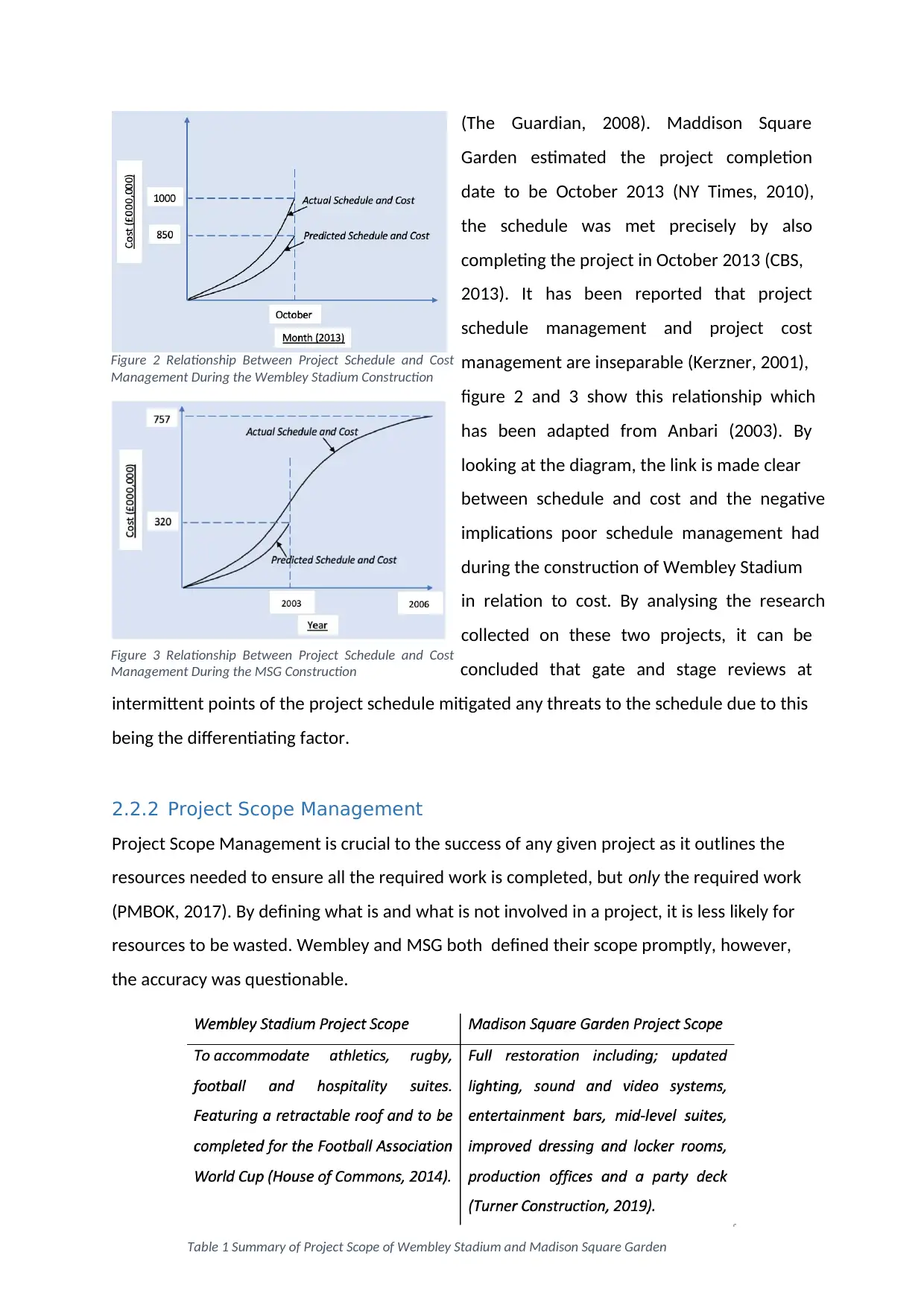
(The Guardian, 2008). Maddison Square
Garden estimated the project completion
date to be October 2013 (NY Times, 2010),
the schedule was met precisely by also
completing the project in October 2013 (CBS,
2013). It has been reported that project
schedule management and project cost
management are inseparable (Kerzner, 2001),
figure 2 and 3 show this relationship which
has been adapted from Anbari (2003). By
looking at the diagram, the link is made clear
between schedule and cost and the negative
implications poor schedule management had
during the construction of Wembley Stadium
in relation to cost. By analysing the research
collected on these two projects, it can be
concluded that gate and stage reviews at
intermittent points of the project schedule mitigated any threats to the schedule due to this
being the differentiating factor.
2.2.2 Project Scope Management
Project Scope Management is crucial to the success of any given project as it outlines the
resources needed to ensure all the required work is completed, but only the required work
(PMBOK, 2017). By defining what is and what is not involved in a project, it is less likely for
resources to be wasted. Wembley and MSG both defined their scope promptly, however,
the accuracy was questionable.
Figure 2 Relationship Between Project Schedule and Cost
Management During the Wembley Stadium Construction
Figure 3 Relationship Between Project Schedule and Cost
Management During the MSG Construction
Table 1 Summary of Project Scope of Wembley Stadium and Madison Square Garden
Garden estimated the project completion
date to be October 2013 (NY Times, 2010),
the schedule was met precisely by also
completing the project in October 2013 (CBS,
2013). It has been reported that project
schedule management and project cost
management are inseparable (Kerzner, 2001),
figure 2 and 3 show this relationship which
has been adapted from Anbari (2003). By
looking at the diagram, the link is made clear
between schedule and cost and the negative
implications poor schedule management had
during the construction of Wembley Stadium
in relation to cost. By analysing the research
collected on these two projects, it can be
concluded that gate and stage reviews at
intermittent points of the project schedule mitigated any threats to the schedule due to this
being the differentiating factor.
2.2.2 Project Scope Management
Project Scope Management is crucial to the success of any given project as it outlines the
resources needed to ensure all the required work is completed, but only the required work
(PMBOK, 2017). By defining what is and what is not involved in a project, it is less likely for
resources to be wasted. Wembley and MSG both defined their scope promptly, however,
the accuracy was questionable.
Figure 2 Relationship Between Project Schedule and Cost
Management During the Wembley Stadium Construction
Figure 3 Relationship Between Project Schedule and Cost
Management During the MSG Construction
Table 1 Summary of Project Scope of Wembley Stadium and Madison Square Garden
⊘ This is a preview!⊘
Do you want full access?
Subscribe today to unlock all pages.

Trusted by 1+ million students worldwide
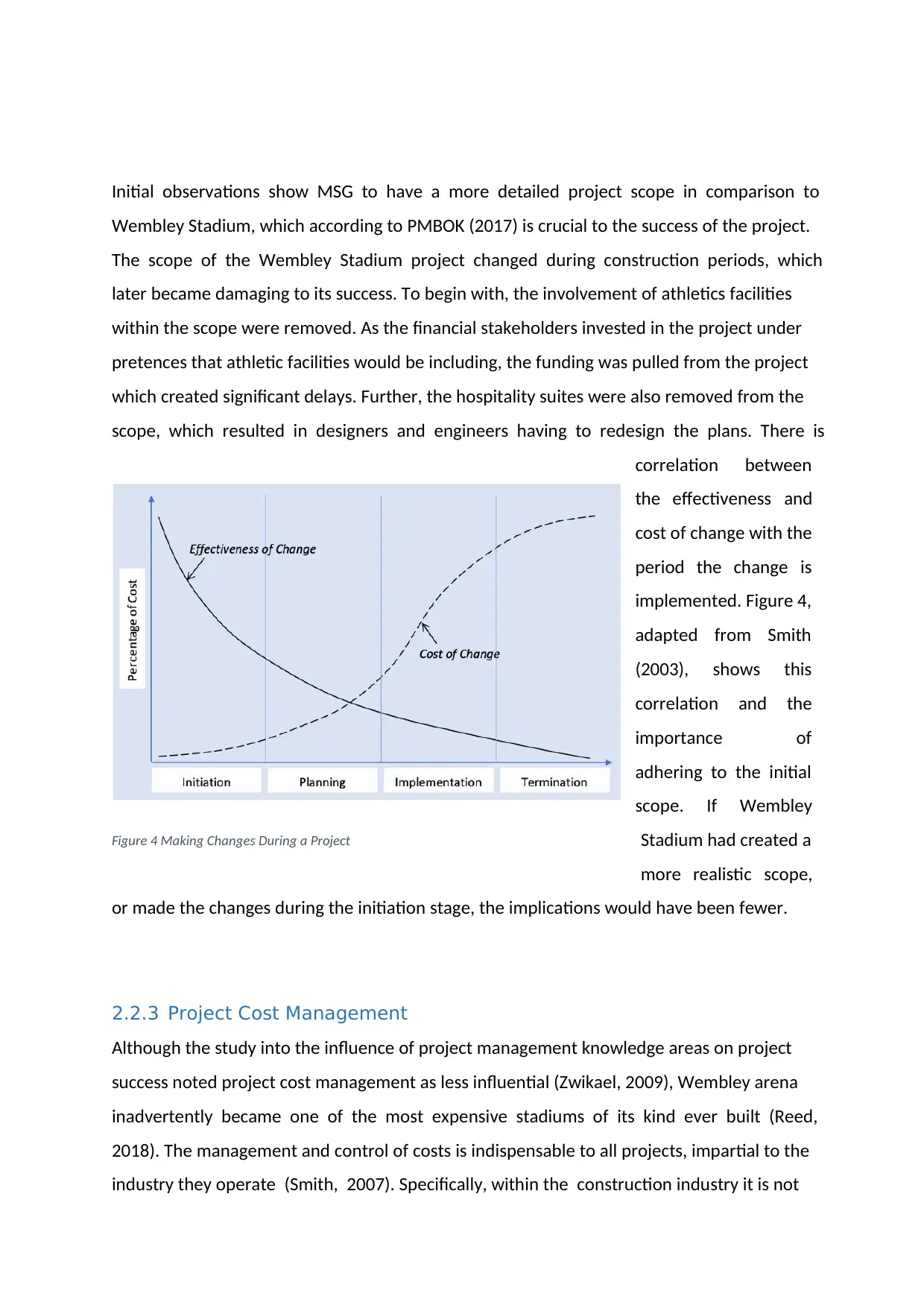
Initial observations show MSG to have a more detailed project scope in comparison to
Wembley Stadium, which according to PMBOK (2017) is crucial to the success of the project.
The scope of the Wembley Stadium project changed during construction periods, which
later became damaging to its success. To begin with, the involvement of athletics facilities
within the scope were removed. As the financial stakeholders invested in the project under
pretences that athletic facilities would be including, the funding was pulled from the project
which created significant delays. Further, the hospitality suites were also removed from the
scope, which resulted in designers and engineers having to redesign the plans. There is
correlation between
the effectiveness and
cost of change with the
period the change is
implemented. Figure 4,
adapted from Smith
(2003), shows this
correlation and the
importance of
adhering to the initial
scope. If Wembley
Stadium had created a
more realistic scope,
or made the changes during the initiation stage, the implications would have been fewer.
2.2.3 Project Cost Management
Although the study into the influence of project management knowledge areas on project
success noted project cost management as less influential (Zwikael, 2009), Wembley arena
inadvertently became one of the most expensive stadiums of its kind ever built (Reed,
2018). The management and control of costs is indispensable to all projects, impartial to the
industry they operate (Smith, 2007). Specifically, within the construction industry it is not
Figure 4 Making Changes During a Project
Wembley Stadium, which according to PMBOK (2017) is crucial to the success of the project.
The scope of the Wembley Stadium project changed during construction periods, which
later became damaging to its success. To begin with, the involvement of athletics facilities
within the scope were removed. As the financial stakeholders invested in the project under
pretences that athletic facilities would be including, the funding was pulled from the project
which created significant delays. Further, the hospitality suites were also removed from the
scope, which resulted in designers and engineers having to redesign the plans. There is
correlation between
the effectiveness and
cost of change with the
period the change is
implemented. Figure 4,
adapted from Smith
(2003), shows this
correlation and the
importance of
adhering to the initial
scope. If Wembley
Stadium had created a
more realistic scope,
or made the changes during the initiation stage, the implications would have been fewer.
2.2.3 Project Cost Management
Although the study into the influence of project management knowledge areas on project
success noted project cost management as less influential (Zwikael, 2009), Wembley arena
inadvertently became one of the most expensive stadiums of its kind ever built (Reed,
2018). The management and control of costs is indispensable to all projects, impartial to the
industry they operate (Smith, 2007). Specifically, within the construction industry it is not
Figure 4 Making Changes During a Project
Paraphrase This Document
Need a fresh take? Get an instant paraphrase of this document with our AI Paraphraser
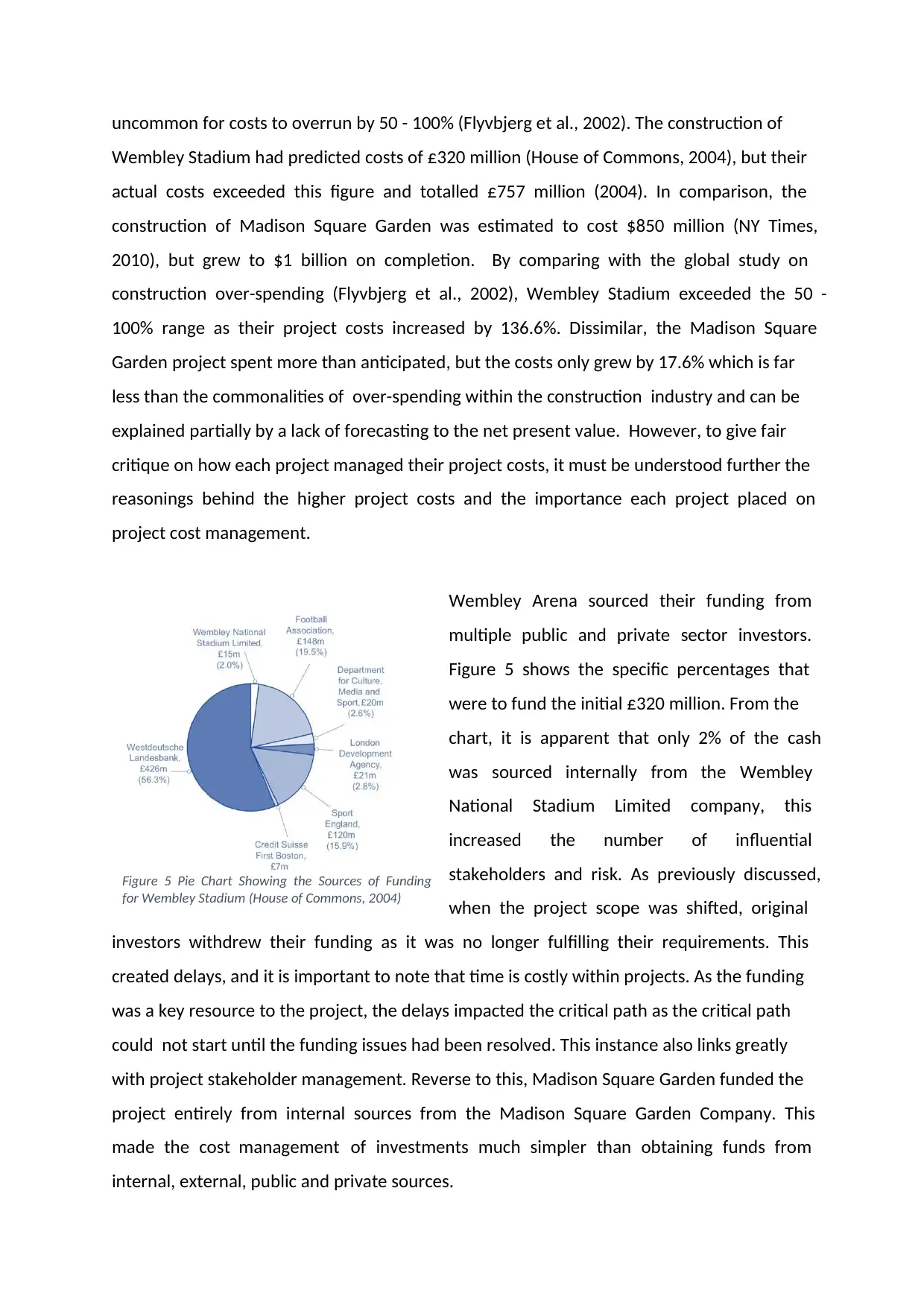
uncommon for costs to overrun by 50 - 100% (Flyvbjerg et al., 2002). The construction of
Wembley Stadium had predicted costs of £320 million (House of Commons, 2004), but their
actual costs exceeded this figure and totalled £757 million (2004). In comparison, the
construction of Madison Square Garden was estimated to cost $850 million (NY Times,
2010), but grew to $1 billion on completion. By comparing with the global study on
construction over-spending (Flyvbjerg et al., 2002), Wembley Stadium exceeded the 50 -
100% range as their project costs increased by 136.6%. Dissimilar, the Madison Square
Garden project spent more than anticipated, but the costs only grew by 17.6% which is far
less than the commonalities of over-spending within the construction industry and can be
explained partially by a lack of forecasting to the net present value. However, to give fair
critique on how each project managed their project costs, it must be understood further the
reasonings behind the higher project costs and the importance each project placed on
project cost management.
Wembley Arena sourced their funding from
multiple public and private sector investors.
Figure 5 shows the specific percentages that
were to fund the initial £320 million. From the
chart, it is apparent that only 2% of the cash
was sourced internally from the Wembley
National Stadium Limited company, this
increased the number of influential
stakeholders and risk. As previously discussed,
when the project scope was shifted, original
investors withdrew their funding as it was no longer fulfilling their requirements. This
created delays, and it is important to note that time is costly within projects. As the funding
was a key resource to the project, the delays impacted the critical path as the critical path
could not start until the funding issues had been resolved. This instance also links greatly
with project stakeholder management. Reverse to this, Madison Square Garden funded the
project entirely from internal sources from the Madison Square Garden Company. This
made the cost management of investments much simpler than obtaining funds from
internal, external, public and private sources.
Figure 5 Pie Chart Showing the Sources of Funding
for Wembley Stadium (House of Commons, 2004)
Wembley Stadium had predicted costs of £320 million (House of Commons, 2004), but their
actual costs exceeded this figure and totalled £757 million (2004). In comparison, the
construction of Madison Square Garden was estimated to cost $850 million (NY Times,
2010), but grew to $1 billion on completion. By comparing with the global study on
construction over-spending (Flyvbjerg et al., 2002), Wembley Stadium exceeded the 50 -
100% range as their project costs increased by 136.6%. Dissimilar, the Madison Square
Garden project spent more than anticipated, but the costs only grew by 17.6% which is far
less than the commonalities of over-spending within the construction industry and can be
explained partially by a lack of forecasting to the net present value. However, to give fair
critique on how each project managed their project costs, it must be understood further the
reasonings behind the higher project costs and the importance each project placed on
project cost management.
Wembley Arena sourced their funding from
multiple public and private sector investors.
Figure 5 shows the specific percentages that
were to fund the initial £320 million. From the
chart, it is apparent that only 2% of the cash
was sourced internally from the Wembley
National Stadium Limited company, this
increased the number of influential
stakeholders and risk. As previously discussed,
when the project scope was shifted, original
investors withdrew their funding as it was no longer fulfilling their requirements. This
created delays, and it is important to note that time is costly within projects. As the funding
was a key resource to the project, the delays impacted the critical path as the critical path
could not start until the funding issues had been resolved. This instance also links greatly
with project stakeholder management. Reverse to this, Madison Square Garden funded the
project entirely from internal sources from the Madison Square Garden Company. This
made the cost management of investments much simpler than obtaining funds from
internal, external, public and private sources.
Figure 5 Pie Chart Showing the Sources of Funding
for Wembley Stadium (House of Commons, 2004)
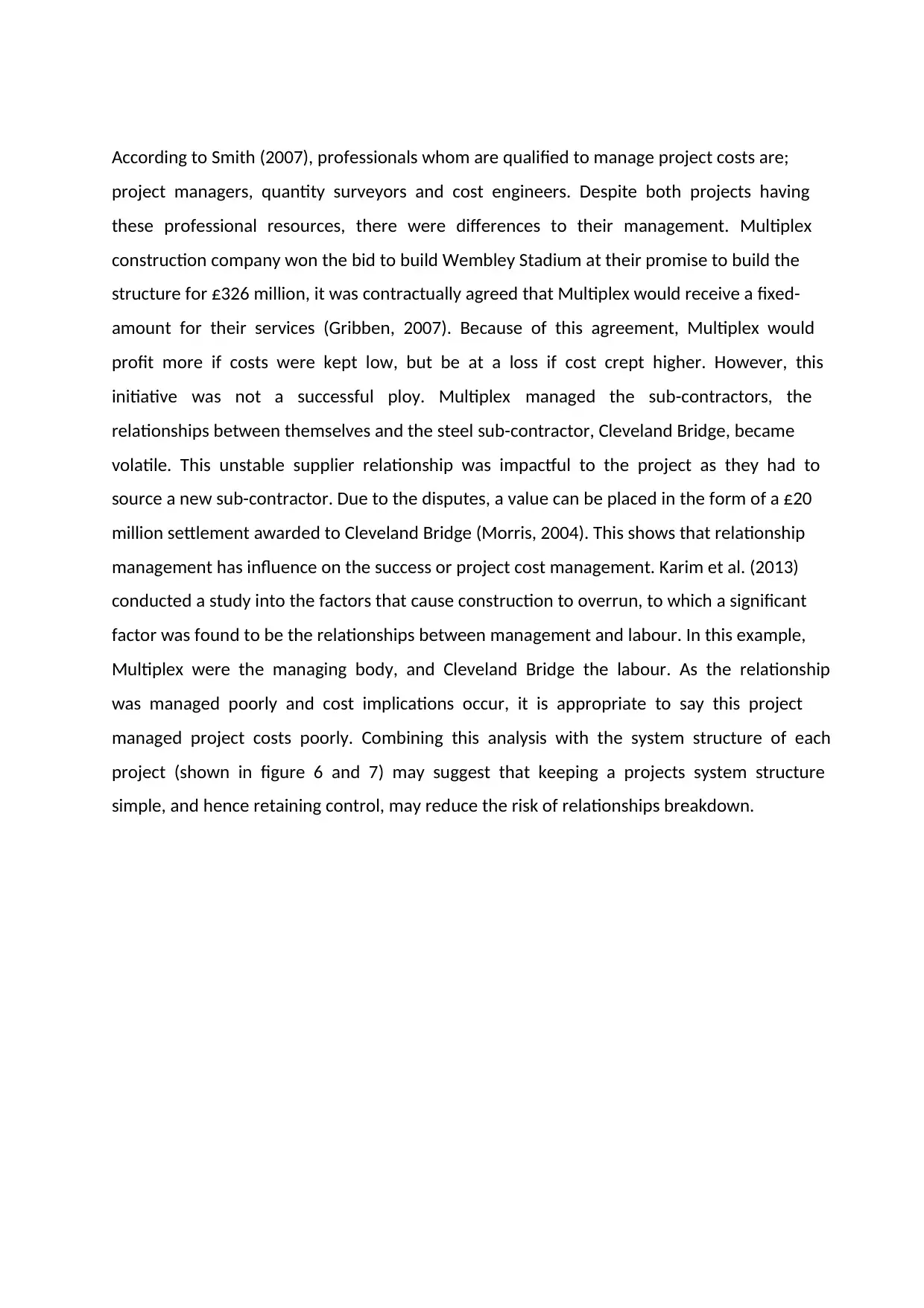
According to Smith (2007), professionals whom are qualified to manage project costs are;
project managers, quantity surveyors and cost engineers. Despite both projects having
these professional resources, there were differences to their management. Multiplex
construction company won the bid to build Wembley Stadium at their promise to build the
structure for £326 million, it was contractually agreed that Multiplex would receive a fixed-
amount for their services (Gribben, 2007). Because of this agreement, Multiplex would
profit more if costs were kept low, but be at a loss if cost crept higher. However, this
initiative was not a successful ploy. Multiplex managed the sub-contractors, the
relationships between themselves and the steel sub-contractor, Cleveland Bridge, became
volatile. This unstable supplier relationship was impactful to the project as they had to
source a new sub-contractor. Due to the disputes, a value can be placed in the form of a £20
million settlement awarded to Cleveland Bridge (Morris, 2004). This shows that relationship
management has influence on the success or project cost management. Karim et al. (2013)
conducted a study into the factors that cause construction to overrun, to which a significant
factor was found to be the relationships between management and labour. In this example,
Multiplex were the managing body, and Cleveland Bridge the labour. As the relationship
was managed poorly and cost implications occur, it is appropriate to say this project
managed project costs poorly. Combining this analysis with the system structure of each
project (shown in figure 6 and 7) may suggest that keeping a projects system structure
simple, and hence retaining control, may reduce the risk of relationships breakdown.
project managers, quantity surveyors and cost engineers. Despite both projects having
these professional resources, there were differences to their management. Multiplex
construction company won the bid to build Wembley Stadium at their promise to build the
structure for £326 million, it was contractually agreed that Multiplex would receive a fixed-
amount for their services (Gribben, 2007). Because of this agreement, Multiplex would
profit more if costs were kept low, but be at a loss if cost crept higher. However, this
initiative was not a successful ploy. Multiplex managed the sub-contractors, the
relationships between themselves and the steel sub-contractor, Cleveland Bridge, became
volatile. This unstable supplier relationship was impactful to the project as they had to
source a new sub-contractor. Due to the disputes, a value can be placed in the form of a £20
million settlement awarded to Cleveland Bridge (Morris, 2004). This shows that relationship
management has influence on the success or project cost management. Karim et al. (2013)
conducted a study into the factors that cause construction to overrun, to which a significant
factor was found to be the relationships between management and labour. In this example,
Multiplex were the managing body, and Cleveland Bridge the labour. As the relationship
was managed poorly and cost implications occur, it is appropriate to say this project
managed project costs poorly. Combining this analysis with the system structure of each
project (shown in figure 6 and 7) may suggest that keeping a projects system structure
simple, and hence retaining control, may reduce the risk of relationships breakdown.
⊘ This is a preview!⊘
Do you want full access?
Subscribe today to unlock all pages.

Trusted by 1+ million students worldwide
1 out of 23
Related Documents
Your All-in-One AI-Powered Toolkit for Academic Success.
+13062052269
info@desklib.com
Available 24*7 on WhatsApp / Email
![[object Object]](/_next/static/media/star-bottom.7253800d.svg)
Unlock your academic potential
Copyright © 2020–2025 A2Z Services. All Rights Reserved. Developed and managed by ZUCOL.





